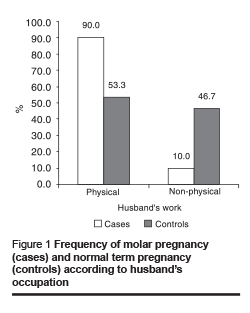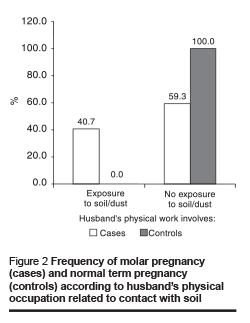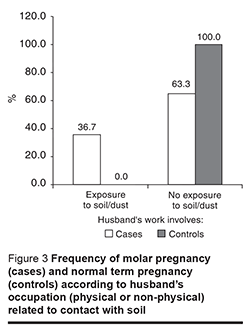H. Shamshiri-Milani1
الحمل الرَحَوي ومهنة الزوج: هل للتـربة والغبار دور في حدوثه؟
حورية شمشيري ميلاني
الخلاصـة: في هذه الدراسة للحالات وشواهدها تم بحث الترابُط بين الحمل الرَحَوي وبين مهنة الزوج. وقد بلغ عدد الحالات المدروسة التي شملها التحليل 30 امرأة يعانين من حمل رَحَوي، وعدد الشواهد 30 امرأة مماثلات لهن في العمر من ذوات الحمل المكتمل المدة. وبيَّن التحليل أن مِهَن أزواج الحالات المدروسة تنطوي على الأرجح على أعمال جسمانية، تُعرِّضهم في أكثر الحالات للتـراب والغبار (0.01> P). وقد أسفرت المقارنة مع جميع المهن التي لا تنطوي على التعرُّض لهما (سواء كانت جسمانية أم غير جسمانية) عن فروق يُعْتَدُّ بها إحصائياً في معدل حدوث الحمل الرحوي (0.001> P).
ABSTRACT: This case–control study investigated the association between molar pregnancy and husband’s work. In the analysis, cases were 30 women with complete mole and controls were 30 matched women with term pregnancies. The husband’s of cases were more likely to have occupations involving physical work than non-physical work and this physical work more usually involved exposure to soil and dust. Among all occupations, the husband’s of cases were more likely to have occupations which had exposure to soil and dust (P < 0.01). Comparing all occupations that had exposure to soil and dust with all those who did not have this exposure (physical and non-physical) resulted in a statistically significant difference in the occurrence of molar pregnancy (P < 0.001).
Grossesse molaire et activité professionnelle du conjoint : les souillures et les poussières jouent‑elles un rôle ?
RÉSUMÉ: Cette étude cas‑témoins a examiné l’association entre la grossesse molaire, ou môle hydatiforme, et l’activité professionnelle du conjoint. Pour les besoins de l’analyse, les cas se composaient de 30 femmes présentant une môle complète et les témoins de 30 femmes appariées à terme. Les conjoints des cas étaient davantage susceptibles d’exercer une profession impliquant un travail physique qu’un travail non physique, travail les exposant plus spécifiquement aux souillures et poussières. Si l’on considère l’ensemble des métiers, les conjoints des cas se sont avérés plus susceptibles d’avoir une profession comportant une exposition aux souillures et poussières (p < 0,01). La comparaison de l’ensemble des professions entraînant cette exposition aux souillures et poussières avec celles qui en sont exemptes (que le travail soit physique ou non) a fait ressortir une différence statistiquement significative en termes de survenue des grossesses molaires (p < 0,001).
1Department of Health and Social Medicine, Faculty of Medicine, Shaheed Beheshti Medical University, Tehran, Islamic Republic of Iran (Correspondence to H. Shamshiri-Milani:
This e-mail address is being protected from spambots. You need JavaScript enabled to view it
).
Received: 31/08/05; accepted: 20/11/05
EMHJ, 2008, 14(1): 183-188
Introduction
Molar pregnancy (hydatidiform mole) is a pathological condition and has adverse effects on women’s health [1]. It occurs when fertilization occurs abnormally. Cytogenetic studies of complete mole have identified the chromosomes completely of paternal origin (androgenesis) [2,3]. Although age, geographic location, ethnicity, low socioeconomic status, history of previous mole or abortion, history of oral contraceptive or intrauterine device use, blood group, radiation and artificial insemination have been suggested as risk factors, little is known about its etiology [4–15].
In the observation of the author, molar pregnancy appears to occur more frequently among women whose husband’s are involved in certain occupations such as agriculture, gardening and construction work. Thus could there be any relationship between molar pregnancy and husband’s occupation? It is known that occupation can affect people’s health and may cause differences in mortality and morbidity rates [16]. There have been few studies about the relationship between molar pregnancy and husband’s occupation [17]. This study was therefore conducted to determine if there is a relationship between the occurrence of molar pregnancy and husband’s occupation, particularly occupations that involve contact with soil and dust.
Methods
A case–control study was conducted in 1993 at the Mirzakochek Khan teaching hospital in Tehran. After verbal explanation of the study and obtaining consent, an interview questionnaire was completed by 43 women who had suffered a complete mole pregnancy and 300 who had had normal term deliveries at the same hospital and in the same period of time. Certain sociodemographic and obstetric and gynaecological data about the women were recorded as well as information about the husbands’ occupations and whether it involved physical work and contact with soil and dust.
After data collection, the 2 groups of women (mothers with molar pregnancies and mothers with term deliveries) were matched by woman’s age group, husband’s age group, history of previous abortion, parity, history oral contraceptive or intrauterine device use, woman’s occupation, woman’s ethnicity, and smoking habits of the women and their husbands. After matching, 30 controls were found for 30 cases. The only difference between them were the husbands’ occupations. The data were then analysed in relation to husband’s occupation. The chi-squared and Fisher exact tests were used to analyse all the variables and the odds ratios (OR) and 95% confidence intervals (CI) were calculated. P ≤ 0.05 was considered statistically significant. SPSS, version 10.1 was used for statistical analysis.
Results
The age groups and other demographic data are shown in Table 1.
There were no statistically significant differences between the 2 groups of women in relation to any of the 10 variables (Table 1). However, significant differences were found with regard to husband s’ occupation (Figure 1). The husbands of women with molar pregnancies were more likely to have a physical occupation than a non-physical occupation (OR = 7.8, 95% CI: 6.28–15.58) (P < 0.05). Furthermore, with regard to those with physical occupation, the husbands of women with molar pregnancies were more likely to have physical jobs that involved exposure to soil and dust (P < 0.01) (Figure 2). Comparing all occupations that had exposure to soil and dust with all those who did not have this exposure (physical and non-physical) resulted in a statistically significant difference (P < 0.001) (Figure 3).



Discussion
Environmental factors have been suggested as risk factors for molar pregnancy [12], but there are few reports about the associations between occupation and molar pregnancy. In one review article the authors suggested studying parents’ occupations in future studies [15]. In the another study investigating risk factors for gestational trophoblastic disease, there was no significant difference between the cases and control groups with regard to husband’s occupation [17]. In this study occupational data were classified according to the Index of Industries and Occupations, 1980 Census of Population, with the 6 major categories.
The aim of the present study was to evaluate the relationship between molar pregnancy and husband’s occupation and the role of soil and dust. The results indicate that such a relationship exists. Molar pregnancy begins with fertilization of an empty or normal ovum by 1 or 2 sperm [1–9]. Germ cells and sperms, as other cells in the body, can be influenced by environmental factors [18]. Therefore it is possible that a husband’s occupation can influence gonads and germ cells, through exposure to some environmental factors, which may in turn lead to abnormal fertilization as occurs in molar pregnancy.
There are some limitations to this study. The data were collected in 1993, the sample size is small and studies on spermatogenesis were not conducted to check the hypothesis. The time factor is unlikely to affect the results since there have not been any changes reported in the pattern, pathology, etiology of molar pregnancy and no other studies have been reported investigating the hypothesis about husbands’ occupation in the mean time. The sample size also is small but was constrained by the availability of such pregnancies as they are relatively rare. A larger sample would yield more reliable and valid information. This would require cooperation between researchers to obtain a large sample. Spermatogenesis analysis was not conducted which could have thrown some light on the effect of the husband’s occupation on this process. This study however was a preliminary attempt to look at the hypothesis of the effect of occupation on molar pregnancy. The results suggest that further studies are warranted.
It is possible that the results of this study could be explained by differences in socioeconomic status and this confounder was not investigated. However, since mother’s occupation was matched between cases and controls and both groups consulted the same governmental hospital, it would seem that the cases and controls were of similar socioeconomic status.
Further research into the association between occupation and molar pregnancy is recommended with larger samples and investigation of the spermatogenesis and fertilization processes.
Acknowledgement
This study was supported by Shaheed Beheshti Medical University and I extend my thanks to them.
References
- Cunningham FG et al., eds. Williams obstetrics, 21st ed. New York, MacGraw–Hill, 2001:835–49.
- Shapter AP, McLellan R. Gestational trophoblastic diseases. Obstetric and gynecology clinics of North America, 2001, 28(4):805–17.
- Li HW, Tsao SW, Cheung AN. Current understandings of the molecular genetics of gestational trophoblastic diseases. Placenta, 2002, 23(1):20–31.
- Tham BW et al. Gestational trophoblastic disease in the Asian population of Northern England and North Wales. British journal of obstetrics and gynaecology, 2003, 110(6):555–9.
- Moodley M, Tunkyi K, Moodley J. Gestational trophoblastic syndrome: an audit of 112 patients. A South African experience. International journal of gynecological cancer, 2003, 13(2):234–9.
- Uberti EM et al. Gestational trophoblastic disease: one more risk in adolescent pregnancy. Acta obstetricia et gynecologica Scandinavica, 2002, 81(4):356–63.
- Nowak-Markwitz E, Drews K, Spaczynski M. Rozrosty i nowotwory trofoblastu--analiza epidemiologiczna 342 chorych. [Gestational trophoblastic disease: the epidemiological analysis of 342 cases.] Ginekologia polska, 2000, 71(8):767–72.
- Di Cintio E et al. The epidemiology of gestational trophoblastic disease. General & diagnostic pathology, 1997, 143(2–3):103–8.
- Palmer JR. Advances in the epidemiology of gestational trophoblastic disease. Journal of reproductive medicine, 1994, 39(3):155–62.
- Parazzini F et al. Risk factors for gestational trophoblastic disease: a separate analysis of complete and partial hydatidiform moles. Obstetrics and gynecology, 1991, 78(6):1039–45.
- Parazzini F et al. Reproductive patterns and the risk of gestational trophoblastic disease. American journal of obstetrics and gynecology, 1985, 152(7 Pt 1):866–70.
- Bracken MB, Brinton LA, Hayashi K. Epidemiology of hydatidiform mole and choriocarcinoma. Epidemiologic reviews, 1984, 6:52–75.
- Grimes DA. Epidemiology of gestational trophoblastic disease. American journal of obstetrics and gynecology, 1984, 150(3):309-18.
- Goldstein DP, Berkowitz RS. Gestational trophoblastic neoplasia, clinical principles of diagnosis & management, 1st ed. Volume 4. Philadelphia, WB Saunders, 1982:221–32.
- Michael B. Brachen D. Incidence and etiology of hydatidiform mole, and epidemiologic review. British journal of obstetrics and gynaecology, 1987, 94:1123–5.
- Park K. Park’s text book of preventive and social medicine, 19th ed. Jabalpur, Banarsidas Bhanot Publishers, 2000:246.
- Messerli ML. Risk factors for gestational trophoblastic neoplasia. American journal of obstetrics and gynecology, 1985, 153(3):294–300.
- Encyclopedia of occupational health and safety, 4th ed. Geneva, International Labour Office, 1998:1418–9, 1200–7.




 Volume 31, number 5 May 2025
Volume 31, number 5 May 2025 WHO Bulletin
WHO Bulletin Pan American Journal of Public Health
Pan American Journal of Public Health The WHO South-East Asia Journal of Public Health (WHO SEAJPH)
The WHO South-East Asia Journal of Public Health (WHO SEAJPH)